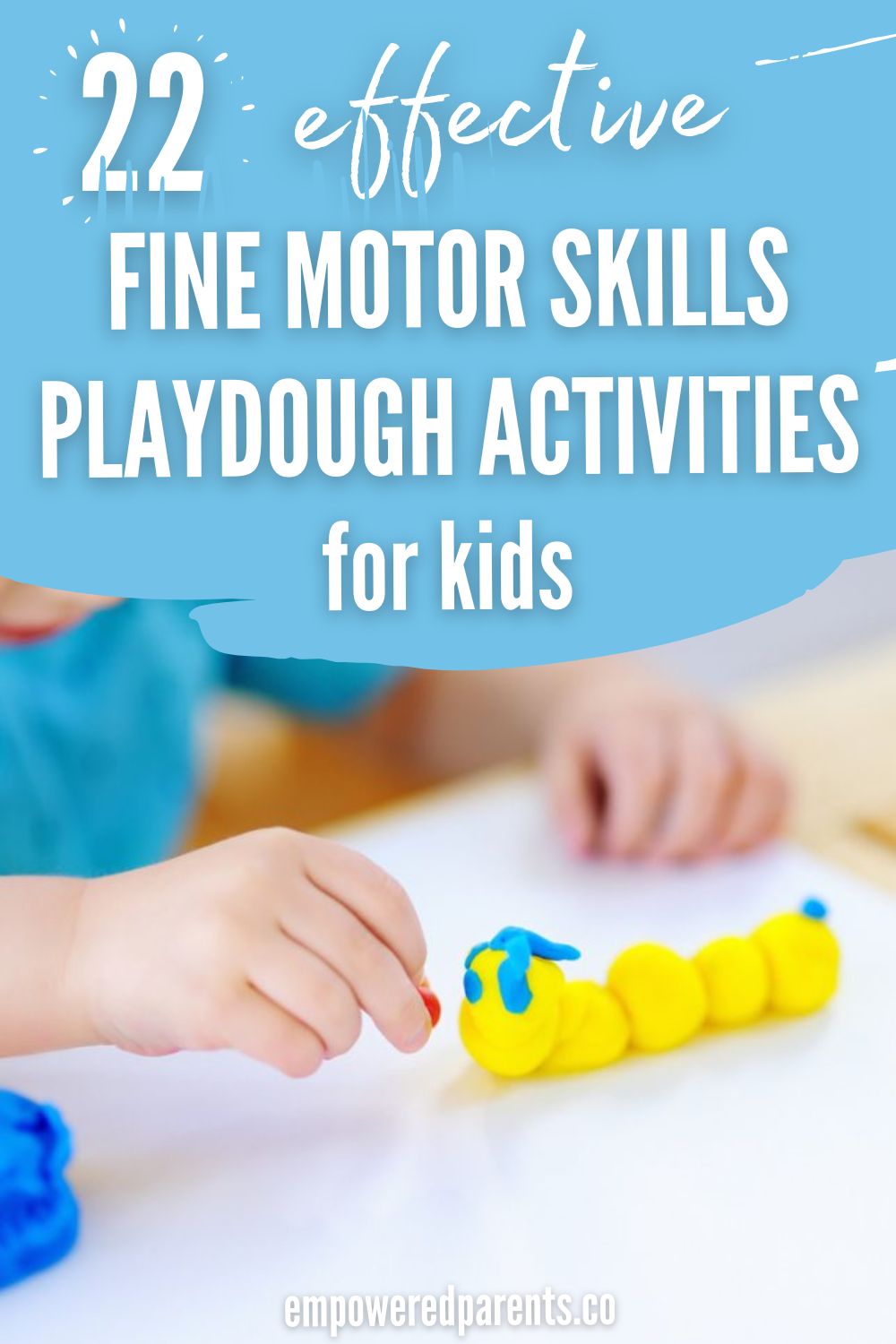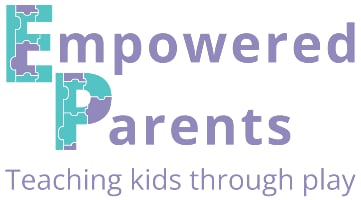Try out these simple playdough fine motor skills activities to strengthen those little muscles in kids’ hands. This is an important step in developing pre-writing skills and independence.
Aside from fine motor development, there are many other benefits of playdough play, such as developing:
- Concentration
- Hand-eye coordination
- Vocabulary
- Social skills
- Bilateral coordination skills
- Problem-solving abilities
- Cognitive skills
Here are some fine motor playdough activity ideas to inject a little more fun into this sensory learning experience. (P.S. There’s a printable at the end of the post!)
Sometimes it is more effective to provide one tool or prop so that kids can practise one skill or learn to use one tool rather than to offer an entire set of playdough utensils.
1. Cookie Cutters
Provide cookie/biscuit cutters or plastic playdough cutters and let kids press the shapes into the playdough.

2. Plastic Knives
Cutting through playdough with plastic knives or blunt kitchen knives is a great way to learn to control tools and build eye-hand coordination.
Practising the cutting skill with playdough can also help children learn to cut their food with a knife, an important independence task.
3. Snakes
Make playdough snakes by pinching off a ball of playdough and rolling them in your hands to make long snakes. Challenge kids to make some short, fat snakes and some long, thin snakes.
Demonstrate the motion of rolling the dough between your two hands as well as rolling it onto the table. This requires a good level of hand control.
4. Make Your Own Playdough
The process of making homemade playdough is in itself an excellent fine motor activity and sensory experience.
It requires measuring out ingredients into cups and spoons, mixing and kneading until the right consistency is achieved.
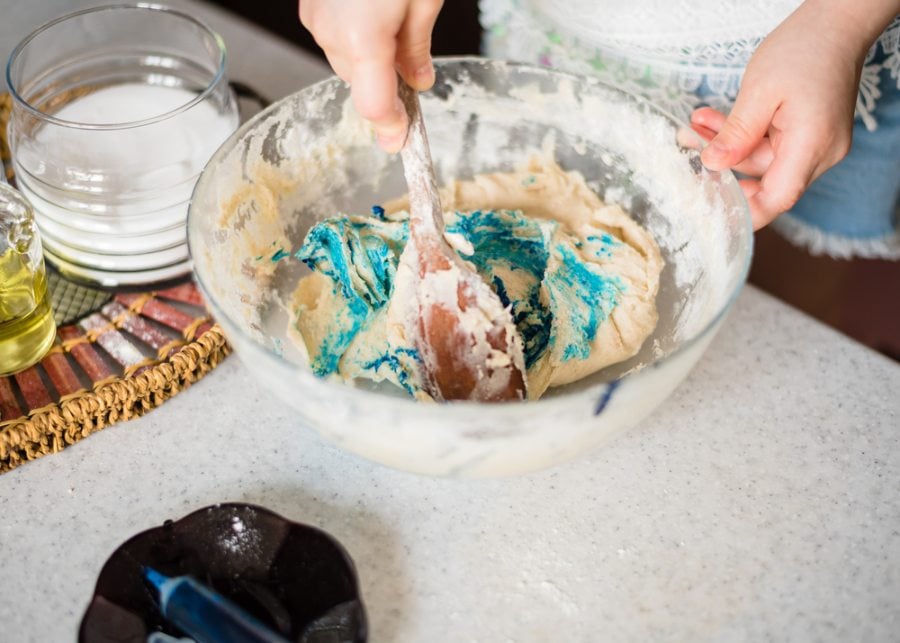
Kneading a batch of playdough is a fun way of getting children to do heavy work, which in turn develops their sense of proprioception. (Heavy work means carrying out strenuous movements like pushing, pulling, crawling, lifting and carrying.)
Here’s a simple playdough recipe:
- Mix 2 cups of flour, 2 teaspoons of vegetable oil and half a cup of salt in a bowl.
- Add a drop or two of food colouring to the water (watch how it mixes with the water).
- Add up to a cup of water slowly as you mix the dough to the desired consistency (use only what you need).
- If the mixture is too sticky, add more flour until you reach the desired consistency.
Here are more simple, no-cook, homemade playdough recipes.
5. Buttons and Beads
Handling small objects like buttons and pony beads requires careful fine motor control.
Kids can press the buttons and beads into the playdough, either randomly or to make shapes/figures with them. Making bead colour patterns can be a simple way to enhance cognitive development.
There are many fun button activities that enhance fine motor skills.
6. Excavating
An alternative to the activity above, hide beads or buttons in a blob of playdough and have kids dig them out with fingers and utensils.
This strengthens the small hand muscles, enhances sensory exploration and builds attention span.
7. Rolling Pins
Give kids multiple opportunities to master the skill of rolling out dough, which requires a lot of hand strength.
They can use kitchen rolling pins or small rolling pins made specially for playdough play. The long tube from inside a roll of paper towels will also work.
8. Cutting Dough
A fun activity for working on scissor skills is to cut the playdough with plastic or safety scissors, or special dough scissors.
Cut shapes or strips of playdough or let kids cut randomly, without specific instructions, so they can practise controlling the scissors with their fingers.
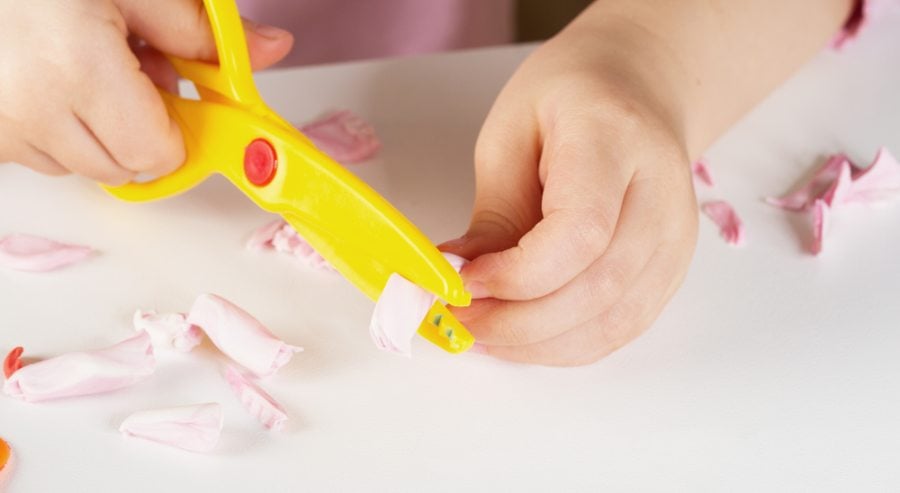
9. Sculpting Dough
Sometimes, playdough can be set out without any props or tools, to encourage free play and creative sculpting.
As children experiment with the dough and learn to control it, they will naturally start to create shapes, objects and figures such as people and animals.
Adults can model this kind of creativity by making simple playdough figures and asking children to make their own creations.
10. Rolling Balls
Kids are more likely to have success at creating objects with playdough if they learn techniques such as pinching the dough, flattening it, or rolling it into long snakes, as mentioned above. Another technique is rolling a blob of playdough into a round ball.
They can roll balls of varying sizes and then make figures out of them, such as a snowman or a caterpillar. This develops hand strength and control, as well as bilateral coordination.

11. Playdough Family
You can even use playdough to help children build body image. Once they have developed confidence with manipulating and moulding the playdough into balls and other shapes, they can make a model of themselves, starting with a body and adding a head, limbs and facial features.
Then challenge them to create their family out of playdough. They can include pets, their home, etc.
12. Colour Mixing
For a fun colour-mixing activity, offer blobs of playdough in the three primary colours and have kids mix pairs of them to create the secondary colours.
This will be a physical workout for their little fingers as they have to knead and mix until the entire blob changes to the new colour so it will be a great strengthening activity.
13. Shells
Provide a bowl of shells of different sizes and let kids experiment by pressing the shells into the playdough to make beautiful patterns, or create a shells-in-the-sand scene.
14. Make Shapes
Children can learn the basic shapes by moulding them out of playdough. This is a wonderfully concrete way to teach shape recognition.
They can cut the different shapes out of the dough with a knife, use shape cutters, or roll the playdough and bend the long strips into shapes.
15. Letters and Numbers
You can also practise letters and numbers by moulding them out of playdough. Learning letters and numbers with hands-on activities is a much more effective strategy than teaching children with flashcards or passive activities.
Start with the letters of a child’s name first and then move on to the rest of the alphabet.

16. Making Tracks
Another fun way to make prints is to use small toy vehicles such as cars and tractors to make track marks with their wheels as they “ride” over the playdough.
17. Loose Parts
Loose parts play has many educational benefits and is any open-ended play that involves small, loose items such as Legos, recycled materials, natural items, beads, coins, dry pasta, pom poms, small toys, straws, etc.
18. Nature Creations
Collect natural items from outside, such as flowers, twigs, acorns and leaves. Children can use these natural materials in their playdough creations.
19. Playdough Mats
Playdough mats are popular with many teachers and they can be simple to make. Print or draw outlines of shapes, images, letters or numbers onto a piece of paper or cardboard. Laminate them if you’d like them to last.
Children can use the outlines as a guide and fill them in with the playdough. Try not to default to only using mats as they need lots of opportunities to be creative, without prescribed guidelines.
20. Stamping Textures
For a fun sensory play activity, provide materials that have interesting textures, such as leaves, pieces of fabric, or any items you can improvise with.
Kids can press them into the playdough and feel the various textures that each imprint creates.
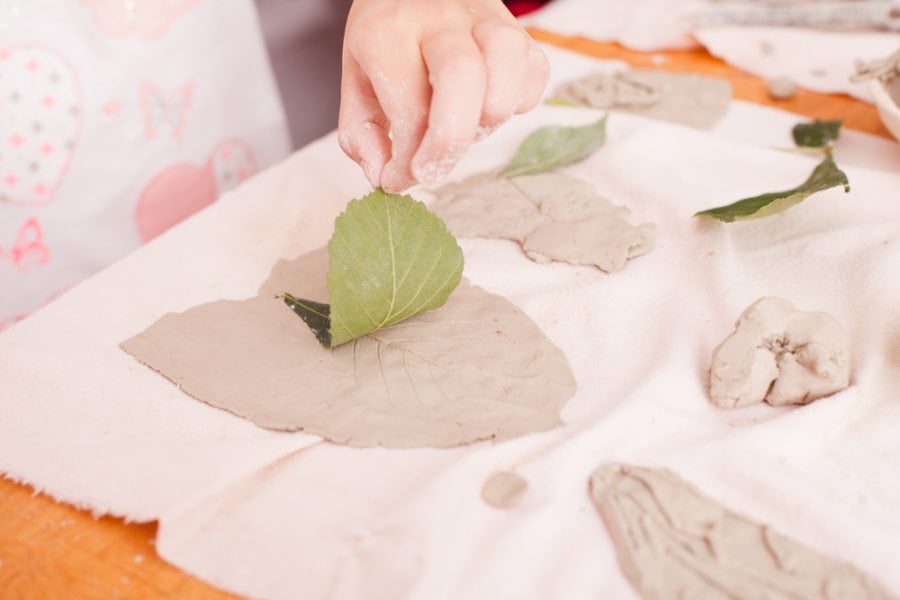
21. Pizza Toppings
Teach kids to roll out a ball of playdough with a rolling pin into the shape of a mini pizza crust, as real chefs do. They can then roll bits of coloured playdough into balls, blobs and other shapes, using them as toppings for their delicious pizzas.
22. Imaginative Play
Encourage children to use the figures they create out of playdough to act out or role play various scenarios, such as going shopping or taking an animal to the vet.
They can also mould props and items that are part of the setting, such as food items in a shop, a shopping trolley, or a table in a vet’s room.
These are just a few ideas for fine-motor playdough activities. Improvise with any tools or items you have on hand and anything that will spark kids’ imagination.
Building Fine Motor Skills with Playdough
Notes
- Cookie Cutters
Let kids press plastic or metal cookie cutters into playdough to create fun shapes. - Plastic Knives
Use plastic or blunt knives to slice through playdough. Great for tool control and independence. - Snakes
Roll playdough into long, thin or short, fat snakes. Roll between hands or on the table. - Make Your Own Playdough
Measure, pour, mix and knead your own dough. Builds fine motor skills and proprioception.
Basic recipe:
– 2 cups flour
– ½ cup salt
– 2 tsp oil
– 1 cup water (add slowly)
– Optional: food colouring - Buttons and Beads
Push buttons or pony beads into the dough. Make patterns or create a picture. - Excavating
Hide beads inside playdough and dig them out using fingers or tools. - Rolling Pins
Roll out dough with kitchen rolling pins or cardboard tubes. Builds hand strength. - Cutting Dough
Use safety scissors to cut dough into strips, shapes, or freely. - Sculpting Dough
Encourage free play with no tools. Make animals, people, or abstract forms. - Rolling Balls
Roll blobs into balls and build with them—like caterpillars or snowmen. - Playdough Family
Make a self-portrait or your whole family with playdough. Include pets too! - Colour Mixing
Mix blobs of primary-coloured dough to discover secondary colours. - Shells
Press shells into dough to make patterns or create beach scenes. - Make Shapes
Create 2D or 3D shapes using hands, cutters or rolled-out ropes of dough. - Letters and Numbers
Form playdough letters and numbers—start with your name! - Making Tracks
Drive small toy cars over playdough to make tyre tracks. - Loose Parts
Add small bits like pasta, pom poms or beads to playdough for creative play. - Nature Creations
Press leaves, twigs and flowers into dough for natural art. - Playdough Mats
Use laminated outlines of letters, numbers or pictures to shape playdough onto. - Stamping Textures
Use fabric scraps, leaves or objects to stamp texture into playdough. - Pizza Toppings
Make mini pizza bases, then create colourful toppings out of dough. - Imaginative Play
Make props for small-world play—like food for a shop or animals at a vet.
